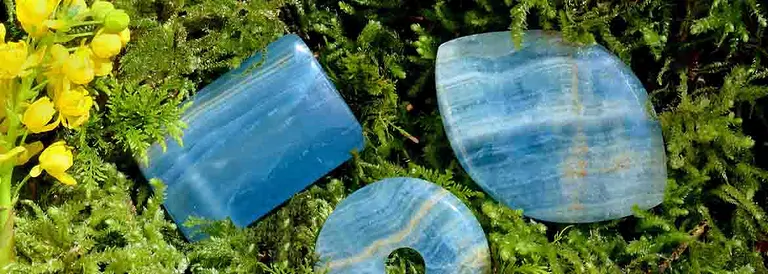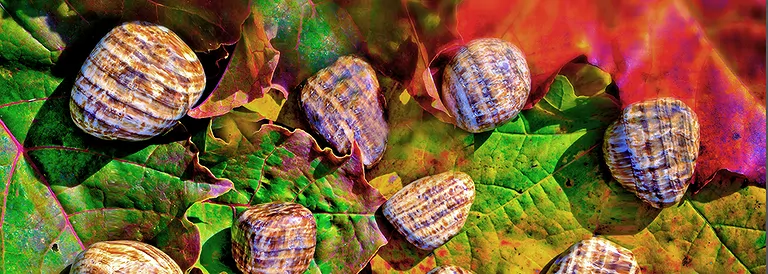
Aragonite - Bearing, effect and application
Aragonite gives us the necessary concentration and focus on the tasks and plans ahead at this crucial time of the year. If everything becomes too much for us or we lose interest, aragonite puts us back on a stable path to success. Serene, yet focused, we can carry out the projects at hand.
Mineralogical Profile Aragonite
Chemical formula, mineral class: CaCO3 + Ba,Fe,Mn,Pb,Sr,Zn; mineral class of carbonates and nitrates. Aragonite is the main component of Mother of Pearl, which makes up pearls.
Emergence: primarily at high pressure from calcareous solutions of magmatic origin on fissures and cavities in basalt and similar volcanic rocks. Secondarily from calcareous water by very rapid crystallization or at warm springs with temperatures above 29° C.
Color: colorless, white; pink, yellow, green, reddish brown, brown, blue or gray due to foreign admixtures
Gloss: vitreous luster; grease luster on cleavage and fracture surface
Transparency: transparent, translucent to opaque depending on the amount of admixtures
Crystal system: rhombic
Moh hardness: 3.5 - 4
Cleavability, fracture: imperfect, conchoidal, brittle fracture
Appearance: prismatic crystals, spherical or ovoid mineral aggregates, columnar and dendritic, parallel fibrous, radial radiating, acicular.
Main supplying countries: Germany (Sasbach/Kaiserstuhl), Greece, Great Britain, Italy, Morocco, Mexico, Namibia, Austria, Pakistan, Poland, Spain, Slovakia, Czech Republic, Turkey, USA
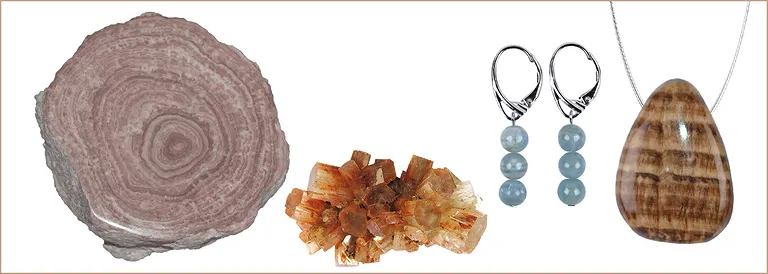
Name, synonyms and varieties of Aragonite
Aragonite received its name in 1788 by Abraham Gottlob Werner, after a locality on the Rio Aragon, Spain. Previously, the mineral was called Aragonian calcite or aragonite.
Occasional retail or wholesale synonyms for aragonite include aphrite, aragon spar, atlas spar, conchite, fibrous aragon, oserskite, pelagosite, perlspar, barkstone, and stem lime. The brown aragonite with cream-colored calcite bands is also called chestnut aragonite.
Known varieties of aragonite include iron flower (white-grayish color, coral-like looking shape), pea stone /pisolite (white-grayish color; radially radiating spheres, concentric shells), and bubbling stone (white-grayish, yellowish, reddish color; undulating calcareous sinter).
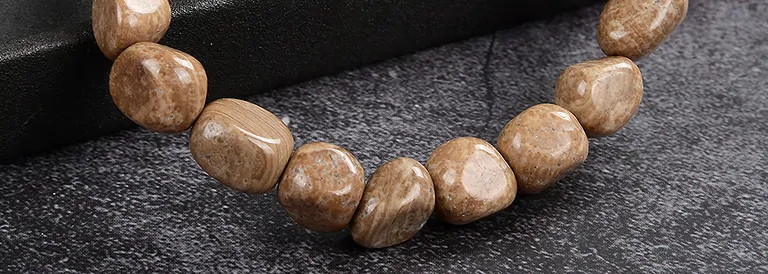
A very special Aragonite: Eichenberger Kugeln
Near the Bregenz (Austria) local mountain "Pfänder" the so-called "Eichenberger Kugeln" are found in the pre-Alpine molasse sediments. These roundish aragonites look completely inconspicuous from the outside, but if one saws through the nodules and polishes them, their beauty and individual grain is revealed. their beauty and individual grain. The formation of the Eichenberg spheres is fascinating: Around a crystallization core, e.g. a piece of a snail from the Miocene, blue-green algae deposit millimeter by millimeter, layer by layer, aragonite. aragonite is deposited millimeter by millimeter, layer by layer, until the cavity is filled; the Eichenberger Kugeln therefore belong to the oncoids. The aragonite nodules can grow up to about 8cm in size and date from the Miocene.
Aragonite sputniks
As if landed from outer space in the forests of the Middle Atlas in Morocco, the aragonite sputniks appear. The roundish crystal aggregates fascinate with their bizarre shapes and red-brown colors caused by iron oxide. The crystal hedgehogs consist of several, intergrown triplet aggregates. The aragonites do not have to be laboriously mined, but are washed out of the clay layer at the bottom of the wadi by the rain.
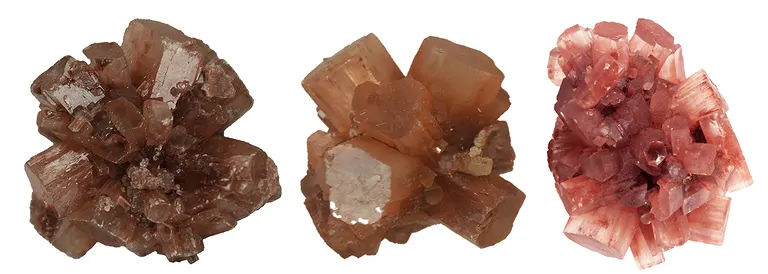
Calcite and Aragonite - gemstone healing aspects
Aragonite and calcite are chemically identical (CaCO3), but have a different crystal structure: calcite is trigonal, aragonite is rhombic. How the external conditions must be, so that the one or just the other one forms mineral is formed, is not yet clearly investigated. Pressure, temperature, magnesium, strontium and the concentration of the solution can play a role according to common theories. In the two minerals "Onyx marble" (mineralogically: Calcite-Aragonite) and Caribbean Calcite (blue-green Calcite with inclusions and streaks of Aragonite), Aragonite and Calcite combine in a visually and energetically very attractive way.
Michael Gienger assigns these themes to the two minerals in his classic book "Die Steinheilkunde":
Aragonite - stabilize developments, calming, flexibility, tolerance, stay on task, balance, implement plans
Calcite -overcoming inertia, putting ideas into action, accelerating developments, stability, self-confidence, steadfastness
The direction of action of the two minerals is thus the same, through the different crystal system a focus can be placed on constancy, pragmatism and the initiation of necessary changes (calcite) or on stabilization after disturbances and support when there is too much adjustment (aragonite).
The brown variety of aragonite (chestnut aragonite) is used when it is necessary to support constant developments. The mineral strengthens in the case of excessive demands and stress and helps to properly assess and implement matters. The American Author Melody assigns aragonite to the sign Capricorn.
